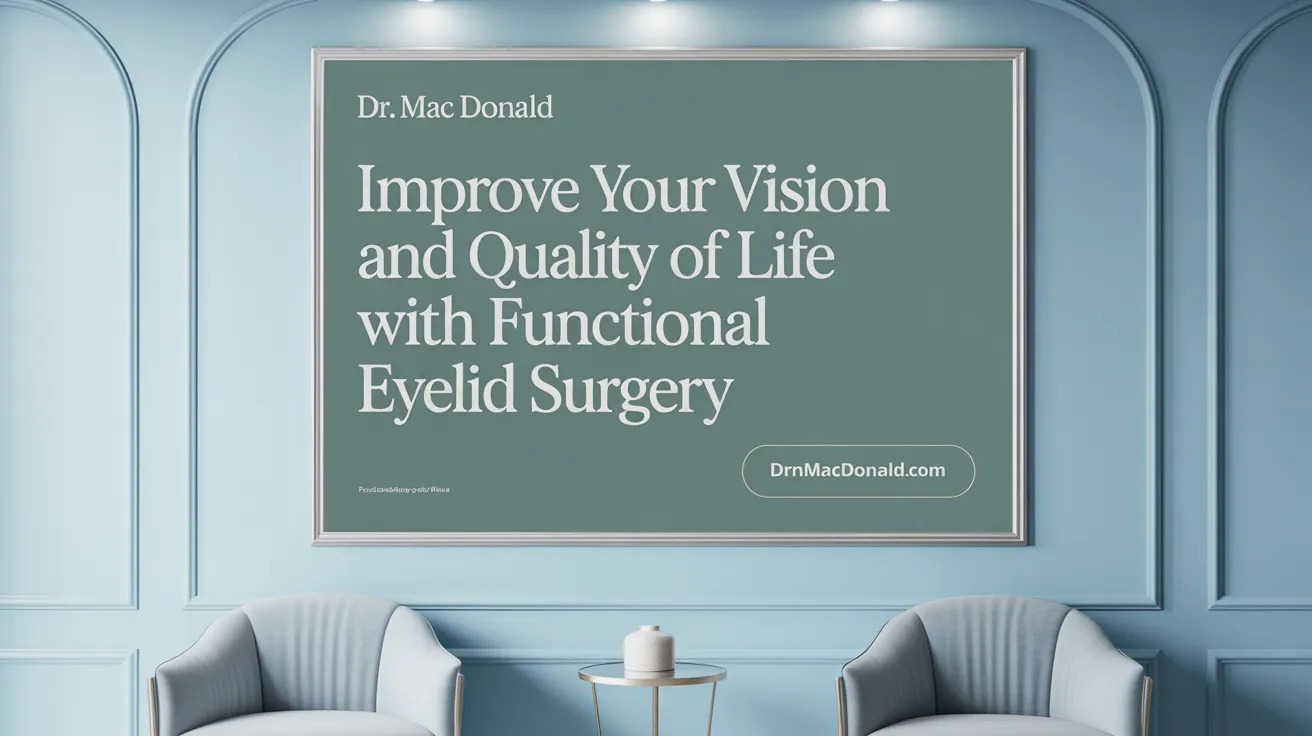Introduction to Functional Eyelid Surgery and Its Benefits
Definition of Blepharoplasty
Blepharoplasty, commonly known as eyelid surgery, is a procedure designed to remove or reposition excess skin, fat, and muscle around the eyelids. This surgery can serve both cosmetic and functional purposes. While it often enhances appearance by creating a more youthful eye contour, it also addresses medical concerns related to impaired vision caused by drooping or sagging eyelids.
Difference Between Cosmetic and Functional Eyelid Surgery
Cosmetic blepharoplasty focuses primarily on aesthetics—improving eye shape, reducing puffiness, and rejuvenating tired-looking eyes. In contrast, functional eyelid surgery aims to restore or improve vision obstructed by excess eyelid tissue. Patients with heavy upper eyelids or significant skin hooding that block the visual field are candidates for functional blepharoplasty. This distinction is important because functional surgery is often considered medically necessary and is typically covered by insurance.
How Blepharoplasty Improves Vision
Excess skin and drooping eyelids can obscure the upper and peripheral visual fields, impairing activities such as reading and driving. By making an incision along the natural eyelid crease, the surgeon removes surplus skin and fat, effectively opening up the line of sight. This results in improved peripheral vision and reduced eye strain, helping patients regain clearer and wider vision.
Minimally Invasive Surgical Approach
Modern blepharoplasty often utilizes minimally invasive techniques, including laser-assisted procedures using CO2 lasers. These advances help minimize bruising, reduce swelling, and promote faster recovery times. The surgery is usually performed under local anesthesia with sedation, lasts less than an hour, and can be conducted either in-office or at a hospital, making it a convenient and patient-friendly option.
What Is Functional Eyelid Surgery and How Does It Improve Vision?

Medical Necessity of Functional Blepharoplasty
Functional blepharoplasty is a specialized surgical procedure aimed primarily at improving vision impaired by drooping or excess eyelid skin rather than serving cosmetic purposes alone. When upper eyelid skin sags enough to obstruct more than 50% of the visual field, this surgery becomes medically necessary. Insurance often covers functional blepharoplasty as it addresses visual impairment rather than purely aesthetic concerns.
Conditions Treated: Ptosis, Dermatochalasis, Brow Ptosis
Functional eyelid surgery treats several conditions that contribute to vision problems. Ptosis results from weakened eyelid muscles, causing eyelids to droop and block the upper field of vision. Dermatochalasis, or excess eyelid skin, and brow ptosis, where the brow sagging further obstructs sight, are also common conditions corrected by this surgery. These issues not only block peripheral vision but may cause irritation through eyelid skin pressing against eyelashes and eyes.
Visual Field Obstruction and Functional Vision Improvement
Droopy upper eyelids can significantly narrow a person’s field of view, resembling a "windowshade" covering the eyes. Surgical correction through blepharoplasty removes redundant skin, muscle, and fat, thereby restoring a clear line of sight and improving peripheral vision. Patients often report enhanced reading ability, reduced eyestrain, and overall better quality of life post-surgery.
Role of Visual Field Testing in Diagnosis and Insurance Coverage
Objective visual field testing plays a crucial role in both diagnosing functional eyelid impairment and in obtaining insurance coverage. These tests quantify how much of the visual field is blocked by drooping eyelids and assess vision improvement when eyelids are manually lifted. Demonstrating significant vision loss is essential for medically justified surgery approval as well as coverage by insurers.
What is minimally invasive cosmetic surgery?
Minimally invasive cosmetic surgery involves procedures with minimal tissue disruption, employing small or hidden incisions and advanced techniques to reduce recovery time and scarring. Blepharoplasty often utilizes these minimally invasive approaches, such as laser-assisted surgery, to effectively remove excess eyelid skin for improved vision and aesthetic refinement with less bruising and faster healing.
Surgical Techniques and Recovery in Functional Blepharoplasty

Incision Placement in the Natural Eyelid Crease
Functional blepharoplasty involves making precise incisions typically within the natural crease of the upper eyelid. This strategic placement ensures that post-surgical scars remain well concealed, providing a smooth and youthful eyelid contour without visible marks. The Upper Eyelid Crease Incision grants direct access to remove excess skin, muscle, and fat that impede vision.
Use of CO2 Laser Technology
Advanced Laser blepharoplasty with CO2 lasers is increasingly used in blepharoplasty to perform the skin incisions and tissue removal. Laser-assisted blepharoplasty offers benefits such as less bruising, reduced swelling, and faster recovery times compared to traditional methods. The precision of the laser minimizes damage to surrounding tissue, enhancing patient comfort and healing.
Duration and Setting of the Procedure
Typically, functional blepharoplasty procedures last under one hour and can be safely performed in either a physician’s office or an outpatient hospital setting. Local anesthesia with sedation is commonly used, allowing patients to recover comfortably and return home the same day. For more on in-office and hospital surgical options, see the linked resource.
Post-Operative Recovery, Bruising, and Swelling Timelines
Patients may experience some bruising and swelling after surgery, which generally peaks within the first few days. Most individuals find significant reduction in these symptoms within 7 to 14 days, permitting a return to routine activities. Blepharoplasty recovery details cold compresses and prescribed care routines that aid in speeding up recovery.
Impact on Vision During Recovery
Temporary blurred or light-sensitive vision can occur immediately post-surgery but usually resolves within two to four weeks. Importantly, as swelling diminishes, patients often observe notable Blepharoplasty for Vision Improvement due to the removal of obstructive eyelid tissue.
What types of facial cosmetic procedures are offered at aesthetic surgery centers?
Aesthetic surgery centers typically offer a variety of facial cosmetic procedures, including Blepharoplasty surgery in San Francisco, facelifts, rhinoplasty, Botox, dermal fillers, and laser skin resurfacing. Blepharoplasty for improved vision may be performed using minimally invasive eyelid surgery techniques that simultaneously correct vision obstruction and rejuvenate appearance, ensuring comprehensive facial enhancement.
Combining Functional Eyelid Surgery with Other Facial Procedures

Brow lifts and their role in vision enhancement
Brow lifts are commonly paired with upper eyelid blepharoplasty to enhance visual fields when eyebrow sagging contributes to eyelid drooping. By elevating the brow position through incisions placed above the eyebrows, these procedures alleviate obstruction to peripheral vision, addressing both functional and aesthetic concerns. The resulting minimal scarring becomes less noticeable over time, ensuring a natural look.
Addressing heavy forehead or brow contributing to eyelid drooping
In patients where a heavy or low-positioned forehead or brow causes upper eyelid skin to droop significantly, combined surgery offers an effective solution. This dual approach removes excess skin and elevates structural support, reducing the weight pressing down on the eyelids and thereby improving vision and comfort.
Advantages of combined procedures for comprehensive rejuvenation
When blepharoplasty is performed alongside brow lifts and potentially other facial procedures such as face or neck lifts, the patient benefits from a more harmonious facial rejuvenation. This comprehensive method not only improves visibility and alleviates symptoms like eyestrain and headaches but also restores a more youthful, alert appearance. Recovery may remain straightforward, with most patients noticing enhanced peripheral vision and emotional well-being.
Role of oculoplastic surgeons and expertise needed
Oculoplastic surgeons specialize in detailed eyelid and facial surgeries, ensuring precise correction of both functional and cosmetic eyelid concerns. Their expertise is critical, especially when combining procedures like blepharoplasty with brow lifts, as they understand the complex anatomy and coordinate strategies to maximize visual improvement and aesthetic outcome. Their skill reduces risks and supports optimal healing and long-lasting results.
Personalized Care Approach at Aesthetic Surgery Centers

Customizing blepharoplasty to patient anatomy and vision needs
Each patient presenting for blepharoplasty for improved vision undergoes a thorough evaluation to tailor the surgery precisely to their unique eyelid anatomy and vision challenges. Factors such as excess upper eyelid skin, muscle strength, and any visual field impairment are carefully assessed to determine the optimal surgical approach.
Importance of detailed preoperative assessment including visual field tests
A comprehensive preoperative workup is essential and typically includes visual field testing for eyelid surgery to quantify the extent of vision obstruction caused by drooping or hooded eyelids. This objective data not only guides surgical planning but also supports insurance coverage for blepharoplasty when vision loss exceeds 50%, ensuring the procedure's medical necessity.
Patient consultation and surgical planning
Consultations focus on understanding patient goals, explaining the nuances of upper eyelid blepharoplasty, possible combinations with brow lifts for vision improvement, and discussing the benefits of minimally invasive methods such as laser blepharoplasty with CO2 lasers. Surgeons detail the incision placements—usually hidden within natural creases—to optimize both functional and cosmetic outcomes.
Minimally invasive emphasis to enhance safety and outcomes
Modern blepharoplasty centers prioritize minimally invasive eyelid surgery to reduce bruising, swelling, and recovery time. Use of laser-assisted blepharoplasty technology and in-office procedures under local anesthesia ensure patient comfort while maintaining outstanding surgical precision.
Personalized care in cosmetic and medical eyelid surgery means customizing treatment plans based on detailed assessments and ongoing patient communication. This targeted strategy enhances safety, maximizes visual and aesthetic improvements, and supports a natural, youthful appearance with long-lasting results.
What Patients Should Consider When Choosing Functional Eyelid Surgery

Health status and candidacy
Patients considering functional blepharoplasty candidates should first ensure they are in good overall health without conditions that increase surgical risks. Ideal candidates have drooping or heavy eyelids that impair vision and experience symptoms like eye strain or headaches from brow overuse.
Understanding the medical necessity versus cosmetic desire
It is important to distinguish between surgery for functional blepharoplasty for visual function improvement and purely cosmetic reasons. Functional blepharoplasty addresses visual field obstruction caused by excess skin or drooping eyelids and is often medically necessary, while cosmetic blepharoplasty focuses on rejuvenating appearance.
Insurance coverage criteria
Many insurance companies offer insurance criteria for functional eyelid surgery when eyelid drooping causes significant visual field loss, typically over 50%, proven by visual field test. Preoperative documentation establishing vision impairment is critical for insurance approval.
Importance of surgeon qualification and facility standards
Expertise in Eyelid Reconstruction or plastic surgery specializing in eyelids is crucial. Patients should choose surgeons with proven experience performing functional blepharoplasty using modern techniques like laser-assisted blepharoplasty and minimally invasive approaches. Selecting reputable centers with established safety protocols ensures Blepharoplasty surgery in San Francisco.
Expected outcomes and long-term benefits
Functional blepharoplasty can restore peripheral vision, reduce eyestrain, and relieve headaches. Most patients enjoy improvements lasting 10 years or more. Additionally, surgery often enhances facial appearance, providing a refreshed, alert look as described in Eyelid Surgery Benefits.
What should patients consider when choosing an aesthetic surgery center?
Patients should prioritize centers with experienced Eyelid Surgery in San Francisco specialists who tailor procedures to individual needs. Reviewing patient reviews, safety standards, technology use, and surgeon credentials helps secure a safe, successful surgery and satisfactory outcomes.
